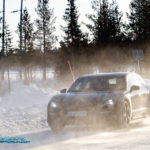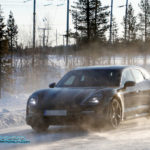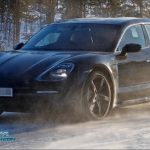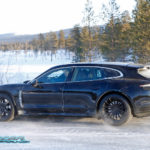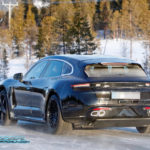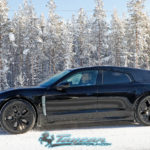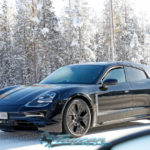

News
Porsche’s more refined Taycan Cross Turismo prototypes spotted in winter tests
Prototypes of the Porsche Taycan Cross Turismo have been spotted winter testing in Sweden recently. Based on images of the vehicle that were captured during the icy road tests, it appears that the Taycan Cross Turismo’s design is steadily coming together.
The new pictures of the Taycan Cross Turismo features a sleek silhouette that echoes much of the design cues present in its sibling — the Porsche Taycan sedan — which is expected to enter production sometime later this year. As noted by TaycanForum.com‘s Tye, Porsche’s recent Cross Turismo test mules now have a more refined rear roofline, rear design, and rear quarter windows.
- The Porsche Taycan Cross Turismo prototype winter testing. (Photo: Tye/TaycanForum.com)
- The Porsche Taycan Cross Turismo prototype winter testing. (Photo: Tye/TaycanForum.com)
- The Porsche Taycan Cross Turismo prototype winter testing. (Photo: Tye/TaycanForum.com)
- The Porsche Taycan Cross Turismo prototype winter testing. (Photo: Tye/TaycanForum.com)
The Porsche Taycan Cross Turismo prototype winter testing. (Photo: Tye/TaycanForum.com)
Similar to the Taycan sedan prototypes, one of the Cross Turismo test mules was equipped with aero wheel covers that appear designed to optimize range. Another unit, this time sporting large brakes on the front wheels, seem to hint at a high-performance variant of the electric car as well. Quite interestingly, Porsche has also fitted its Cross Turismo prototypes with faux exhausts at the rear.
As the Cross Turismo prototypes are starting to become more refined, differences between the vehicle and the Mission E Cross Turismo concept are starting to emerge. Among the most prominent of these differences is in the vehicles’ suspension, with the recent test mules being set up lower than their concept car counterpart. With this in mind, it remains to be seen if the Taycan Cross Turismo would retain its concept version’s rugged theme, considering that it is one of the vehicle’s primary features. When Porsche explained the Cross Turismo concept, for one, the company noted that the vehicle would be capable of going off-road, at least to a certain degree, thanks to its air suspension that could provide more ground clearance when needed.
- The Porsche Taycan Cross Turismo prototype winter testing. (Photo: Tye/TaycanForum.com)
- The Porsche Taycan Cross Turismo prototype winter testing. (Photo: Tye/TaycanForum.com)
- The Porsche Taycan Cross Turismo prototype winter testing. (Photo: Tye/TaycanForum.com)
- The Porsche Taycan Cross Turismo prototype winter testing. (Photo: Tye/TaycanForum.com)
The Porsche Taycan Cross Turismo prototype winter testing. (Photo: Tye/TaycanForum.com)
The Porsche Taycan Cross Turismo is the German automaker’s second all-electric vehicle. Unveiled last year in concept car form, the Cross Turismo was well-received as the Taycan’s (then dubbed as the Mission E sedan) more rugged sibling. Amidst the warm reception for the Taycan sedan after Porsche opened reservations for the vehicle, reports emerged from German media that the automaker’s supervisory board has approved the mass production of the Cross Turismo as well.
To prepare for the vehicle’s production, Porsche is adding around 300 more jobs at its Zuffenhausen site, which is currently being augmented to support the Taycan’s production lines. The Taycan Cross Turismo is expected to start production in 2020, roughly a year after its sedan sibling enters the market. It remains to be seen if the vehicle would also feature a top-tier Turbo variant, similar to the Taycan sedan.

Elon Musk
Elon Musk and Tesla AI Director share insights after empty driver seat Robotaxi rides
The executives’ unoccupied tests hint at the rapid progress of Tesla’s unsupervised Robotaxi efforts.

Tesla CEO Elon Musk and AI Director Ashok Elluswamy celebrated Christmas Eve by sharing personal experiences with Robotaxi vehicles that had no safety monitor or occupant in the driver’s seat. Musk described the system’s “perfect driving” around Austin, while Elluswamy posted video from the back seat, calling it “an amazing experience.”
The executives’ unoccupied tests hint at the rapid progress of Tesla’s unsupervised Robotaxi efforts.
Elon and Ashok’s firsthand Robotaxi insights
Prior to Musk and the Tesla AI Director’s posts, sightings of unmanned Teslas navigating public roads were widely shared on social media. One such vehicle was spotted in Austin, Texas, which Elon Musk acknowleged by stating that “Testing is underway with no occupants in the car.”
Based on his Christmas Eve post, Musk seemed to have tested an unmanned Tesla himself. “A Tesla with no safety monitor in the car and me sitting in the passenger seat took me all around Austin on Sunday with perfect driving,” Musk wrote in his post.
Elluswamy responded with a 2-minute video showing himself in the rear of an unmanned Tesla. The video featured the vehicle’s empty front seats, as well as its smooth handling through real-world traffic. He captioned his video with the words, “It’s an amazing experience!”
Towards Unsupervised operations
During an xAI Hackathon earlier this month, Elon Musk mentioned that Tesla owed be removing Safety Monitors from its Robotaxis in Austin in just three weeks. “Unsupervised is pretty much solved at this point. So there will be Tesla Robotaxis operating in Austin with no one in them. Not even anyone in the passenger seat in about three weeks,” he said. Musk echoed similar estimates at the 2025 Annual Shareholder Meeting and the Q3 2025 earnings call.
Considering the insights that were posted Musk and Elluswamy, it does appear that Tesla is working hard towards operating its Robotaxis with no safety monitors. This is quite impressive considering that the service was launched just earlier this year.
Elon Musk
Starlink passes 9 million active customers just weeks after hitting 8 million
The milestone highlights the accelerating growth of Starlink, which has now been adding over 20,000 new users per day.

SpaceX’s Starlink satellite internet service has continued its rapid global expansion, surpassing 9 million active customers just weeks after crossing the 8 million mark.
The milestone highlights the accelerating growth of Starlink, which has now been adding over 20,000 new users per day.
9 million customers
In a post on X, SpaceX stated that Starlink now serves over 9 million active users across 155 countries, territories, and markets. The company reached 8 million customers in early November, meaning it added roughly 1 million subscribers in under seven weeks, or about 21,275 new users on average per day.
“Starlink is connecting more than 9M active customers with high-speed internet across 155 countries, territories, and many other markets,” Starlink wrote in a post on its official X account. SpaceX President Gwynne Shotwell also celebrated the milestone on X. “A huge thank you to all of our customers and congrats to the Starlink team for such an incredible product,” she wrote.
That growth rate reflects both rising demand for broadband in underserved regions and Starlink’s expanding satellite constellation, which now includes more than 9,000 low-Earth-orbit satellites designed to deliver high-speed, low-latency internet worldwide.
Starlink’s momentum
Starlink’s momentum has been building up. SpaceX reported 4.6 million Starlink customers in December 2024, followed by 7 million by August 2025, and 8 million customers in November. Independent data also suggests Starlink usage is rising sharply, with Cloudflare reporting that global web traffic from Starlink users more than doubled in 2025, as noted in an Insider report.
Starlink’s momentum is increasingly tied to SpaceX’s broader financial outlook. Elon Musk has said the satellite network is “by far” the company’s largest revenue driver, and reports suggest SpaceX may be positioning itself for an initial public offering as soon as next year, with valuations estimated as high as $1.5 trillion. Musk has also suggested in the past that Starlink could have its own IPO in the future.
News
NVIDIA Director of Robotics: Tesla FSD v14 is the first AI to pass the “Physical Turing Test”
After testing FSD v14, Fan stated that his experience with FSD felt magical at first, but it soon started to feel like a routine.

NVIDIA Director of Robotics Jim Fan has praised Tesla’s Full Self-Driving (Supervised) v14 as the first AI to pass what he described as a “Physical Turing Test.”
After testing FSD v14, Fan stated that his experience with FSD felt magical at first, but it soon started to feel like a routine. And just like smartphones today, removing it now would “actively hurt.”
Jim Fan’s hands-on FSD v14 impressions
Fan, a leading researcher in embodied AI who is currently solving Physical AI at NVIDIA and spearheading the company’s Project GR00T initiative, noted that he actually was late to the Tesla game. He was, however, one of the first to try out FSD v14.
“I was very late to own a Tesla but among the earliest to try out FSD v14. It’s perhaps the first time I experience an AI that passes the Physical Turing Test: after a long day at work, you press a button, lay back, and couldn’t tell if a neural net or a human drove you home,” Fan wrote in a post on X.
Fan added: “Despite knowing exactly how robot learning works, I still find it magical watching the steering wheel turn by itself. First it feels surreal, next it becomes routine. Then, like the smartphone, taking it away actively hurts. This is how humanity gets rewired and glued to god-like technologies.”
The Physical Turing Test
The original Turing Test was conceived by Alan Turing in 1950, and it was aimed at determining if a machine could exhibit behavior that is equivalent to or indistinguishable from a human. By focusing on text-based conversations, the original Turing Test set a high bar for natural language processing and machine learning.
This test has been passed by today’s large language models. However, the capability to converse in a humanlike manner is a completely different challenge from performing real-world problem-solving or physical interactions. Thus, Fan introduced the Physical Turing Test, which challenges AI systems to demonstrate intelligence through physical actions.
Based on Fan’s comments, Tesla has demonstrated these intelligent physical actions with FSD v14. Elon Musk agreed with the NVIDIA executive, stating in a post on X that with FSD v14, “you can sense the sentience maturing.” Musk also praised Tesla AI, calling it the best “real-world AI” today.
